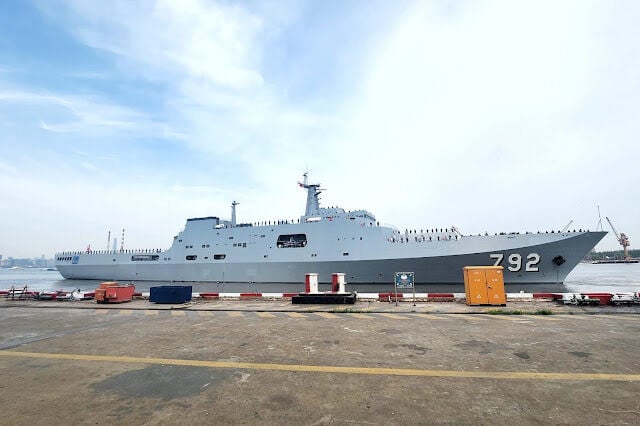Thailand welcomes new controversial Chinese-built amphibious assault ship

Thailand yesterday welcomed a new Chinese-built amphibious assault ship to its naval fleet. The HTMS Chang, a Type 071E landing platform dock, arrived at its homeport in southern Thailand a week after its official handover at the Chinese shipyard.
The ship, which left Hudong-Zhonghua Shipbuilding’s facility in Shanghai on Tuesday, April 18, travelled through the Taiwan Strait before arriving at Chuk Samet Pier by Sattahip Naval Base in Chon Buri province. A ceremony was held to officially hand over the HTMS Chang to the Royal Thai Navy, with the service’s chief, Adm. Choengchai Chomchoengpaet, in attendance, as reported by several news agencies.
The Type 071E is an export variant of the Type 071, which is currently in service with the Chinese People’s Liberation Army Navy. The landing platform dock has a stern well that can carry up to four air-cushioned landing craft for amphibious assaults, while hull-mounted davits can carry, launch, and recover conventional landing craft. It also has a vehicle deck with space for 60 armoured fighting vehicles and can accommodate 800 troops.
However, the acquisition of the HTMS Chang has sparked controversy as Thailand is a US treaty ally, yet it continues to operate several types of Chinese-made platforms, including tanks, frigates, and offshore patrol vessels. The country has also signed a contract to purchase Chinese-made S26T diesel-electric submarines, which has been mired in controversy primarily over the engines that will be used to power the three boats.
Despite this controversy, China’s naval force operates eight Type 071 ships split between its East and South Sea fleets, with the latter responsible for maritime operations in the disputed South China Sea.
Years ago, it was reported that the ship would cost US$200.7 million, with construction lasting three years. Before that, Thai media reports had said the Chinese design would cost US$130 million.
The arrival of the HTMS Chang marks a significant addition to Thailand’s naval capabilities, but it remains to be seen how it will affect the country’s relationship with the US and its allies in the region.
Latest Thailand News
Follow The Thaiger on Google News:


























